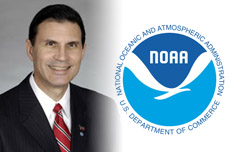
NOAA to expand high-speed data network beyond researchers
Zach Goldstein, the National Oceanic and Atmospheric Administration’s chief information officer, said the agency will expand the N-Wave network to offer mission...
The National Oceanic and Atmospheric Administration is moving away from using separate computer networks for research and mission needs.
This consolidation will give mission areas access to the high-speed network called N-Wave.
“It’s a 10-gig network and it’s going up to 100 gigabytes and what we are doing is moving it from research to operations,” said Zach Goldstein, NOAA’s chief information officer. “It started as the network we built to move our massive amounts of supercomputer data around the country but because of the economics and reliability of the system, we are finding that our mission systems—backups to satellite archiving functions and so on—are using the network as well. Now that we have all these dependencies upon it, we are doing to the network what we do to our model and so many other things a NOAA is transitioning them from research to operations. We’ll be able to use the N-Wave network as the backbone for further network consolidation to improve support to our customers.”
NOAA says N-Wave is a highly scalable, stable and secure network built using 10GB-per-second Wave Division Multiplexed (WDM) fiber-optic links supplied by partners in the national Research and Education (R&E) network community including: Internet2 (I2), the Global Research Network Operations Center (GRNOC) and the National LambdaRail (NLR).
Goldstein said over the next year or two N-Wave will be the largest single network across NOAA. He said he expects NOAA to continue to run a dedicated operational network inside the National Weather Service for handling communications between supercomputers and the folks who generate products from the supercomputers, and also the meteorologists who add their skills to the computer models to produce the best forecast possible.
Goldstein said security requirements for that NWS network is why N-Wave will not be the one NOAA network.
The network consolidation is part of NOAA’s ongoing technology modernization effort.
The Commerce Department bureau was one of the first agencies to move its e-mail to the cloud—moving 25,000 employees to Google Apps for Government in 2012.
Since then, NOAA has made additional awards to Microsoft and Amazon for infrastructure and platform-as-a-service offerings.
Goldstein said the most recent award to Amazon Web Services came in September for $9.9 million.
“We are moving out in a smart way. We are taking out time and organizing our efforts so that we can gain economies of scale, save infrastructure costs and have a single security boundary for multiple systems in the cloud,” he said. “Once our customers are using the cloud, we will have additional economies through systems administration and maintenance. We have these two cloud providers to help use learn how we handle transition and optimize the services we receive.”
He said Office of Marine and Aviation Operations and the National Ocean Service are using the Microsoft Azure cloud.
“We are still working out the mechanism for folks to choose where to go,” Goldstein said. “We are putting together a more formal process for moving to AWS. In both cases what we want to do is get a better handle on the commonality opportunities so we don’t want everybody to simply bring their own system administrator for their instance. We don’t want to have everybody to figure out how they will the security element that is not being provided by the cloud provider, and then we will be putting in place the infrastructure for both and based on the natural parameters of the application that is being moved and the economics, we will make decisions.”
He said NOAA will use the cloud instances for everything from application hosting to storage, with the big opportunity for test and development.
In October, Goldstein announced that his office would create a shared service to acquire, broker and manage single NOAA accounts for AWS and Microsoft.
“The shared service will be incorporated into the NOAA Enterprise IT Services Catalog and operated by the NOAA OCIO Service Delivery Division (SDD) by November 16, 2015,” according to the NOAALink User’s Quarterly newsletter posted to the agency’s website. “The only authorized means of obtaining AWS and Microsoft Azure cloud services is via the NOAA OCIO shared service.”
Commerce CIO Steve Cooper has been pushing the department toward enterprise services for commodity IT over the last year or so. Four working groups have been examining the opportunities across technology, finance, human resources and acquisition.
Goldstein said NOAA will lead the cybersecurity shared services piece.
In fact, NOAA will release a solicitation in the coming months for its cybersecurity center.
“It’s going to differentiate to what we are doing today because in addition to having folks on premise monitoring systems, doing automatic correlation of events, we are looking to industry to see if they can offer us as part of that offering security-as-a-service and other ideas about how we can more efficiently provide corporatewide security services,” he said. “The contract is both to support the Department of Commerce enterprise security operations center and the NOAA computer cybersecurity center. They are co-located. They will share a contractor team. They share infrastructure and they are in the same high impact security boundary.”
Goldstein said the request for proposals is expected in the spring and an award by September.
Copyright © 2025 Federal News Network. All rights reserved. This website is not intended for users located within the European Economic Area.
Jason Miller is executive editor of Federal News Network and directs news coverage on the people, policy and programs of the federal government.
Follow @jmillerWFED





